Services and Technologies
|
|
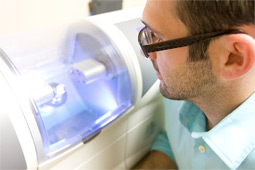
Full Care Dental PLLC has provided personalized dental care to thousands of families. Our patients come from near and far to experience the warm, individualized care we provide. We pride ourselves in utilizing the most modern equipment and methods available.
In order to provide nothing but the best to our patients, our office uses state-of-the-art technologies in all our procedures. These new technologies allow us to detect dental concerns at early stages, treat your dental issues with precision, and provide stunning and customized restorations. Our premium dental software system maximizes your time and our office efficiency. When you visit our office you can be confident that you are receiving the finest and most advanced in dental care.
Click the Services below for more information on each subject.
« Return to Services List
INVISALIGN

Invisalign is a modern aesthetic way of straightening teeth. It requires no wires, metal brackets, or rubber bands. The Aligners are a smooth, stiff, and clear plastic material that fits over your teeth. They are custom made to gently move your teeth according to the Doctors treatment plan. The Aligners gradually move your teeth and new trays are used every two weeks over the course of your treatment. They are made to be taken out while you eat so you can still brush and floss like normal and you could even take them out for a wedding photo session. One of the greatest things about the trays is most people do not even recognize you are wearing them!

« Return to Services List
ORAL HYGIENE CARE
Maintaining good oral hygiene is one of the most important things you can do for your teeth and gums. Healthy teeth not only enable you to look and feel good, they make it possible to eat and speak properly. Good oral health is important to your overall well-being.
Daily preventive care, including proper brushing and flossing, will help stop problems before they develop.
In between regular visits to the dentist, there are simple steps that each of us can take to greatly decrease the risk of developing tooth decay, gum disease and other dental problems. These include:
- Brush thoroughly twice a day and floss daily
- Eat a balanced diet and limit snacks between meals
- Use dental products that contain fluoride, including toothpaste
- Rinse with a fluoride mouth rinse if your dentist advises you to
- Make sure that your children under 12 drink fluoridated water or take a fluoride supplement if they live in a non-fluoridated area
« Return to Services List
ROOT CANAL TREATMENT
Root canal treatment (also referred to as root canal therapy or endodontic therapy) is most commonly made necessary when a cavity is allowed, through neglect, to reach all the way to the pulp. (Regular cleanings and checkups can prevent and detect problems early). Sometimes deep restorations or trauma to a tooth may cause the nerve to be damaged to the point it needs root canal therapy. Once this occurs the pulp becomes infected, and can even extend through the root tip and begin to eat away at the surrounding bone (this is an abscess). By the time the pulp is infected it must be treated, and cannot heal on its own. It can even weaken the entire immune system. This is dangerous, not to mention very painful. Symptoms that may indicate that the pulp has become infected may include sensitivity to hot/cold or sweets, pain, swelling, pain to biting or pressure, and a bad taste in the mouth.
Sometimes, however, no symptoms are apparent and the person is unaware of any problem until a checkup. A root canal is then performed to clean out the infected tooth pulp, and disinfect the canals of the tooth. The only other treatment would be to extract the tooth. Once the infection is resolved, the canal(s) are filled in to prevent any further infection. Usually a core build-up and crown is recommended for restoring a tooth that has had root canal therapy.
« Return to Services List
IMPLANT RESTORATION
A dental implant is an ideal tooth restoration for people who are missing one or more teeth as a result of injury, periodontal disease, or any other reason. A dental implant is a metal post that a periodontist or oral surgeon surgically positions into the jaw. Once in place and bone surrounding the implant has had time to heal, a replacement tooth is attached to the post. While implants are typically more expensive than other methods of tooth replacement, they provide superior benefits and are stronger than natural teeth. They are also a more favorable approach than bridgework since they do not depend on neighboring teeth for support and they cannot decay.
To receive implants, you need to have healthy gums and adequate bone to support the implant. You must also be committed to excellent oral hygiene and regular dental visits as these are critical to the long-term success of dental implants.
« Return to Services List
BONDING
Bonding is a conservative way to repair slightly chipped, discolored, or crooked teeth. During dental bonding, a white filling is placed onto your tooth to improve its appearance. The filling "bonds" with your teeth, and because it comes in a variety of tooth-colored shades it closely matches the appearance of your natural teeth.
Tooth bonding can also be used for teeth fillings instead of amalgam fillings. Many patients prefer bonded fillings because the white color is much less noticeable than the silver amalgam fillings. Bonding fillings can be used on front and back teeth depending on the location and extent of tooth decay.
Bonding is less expensive than other cosmetic treatments and usually can be completed in one visit to our office. However, bonding can stain and is easier to break than other cosmetic treatments such as porcelain veneers. If it does break or chip, tell your doctor. The bonding can generally be easily patched or repaired in one visit.
« Return to Services List
TOOTH EXTRACTIONS
Good oral hygiene should always be practiced since the loss of a single tooth can have major impact upon your oral health and appearance. Although dentists will use every measure to prevent tooth loss, there are still some occasions when a tooth may need to be extracted. A tooth may need to be extracted if the following occurs:
- Severe decay
- Advanced periodontal disease
- Infection or abscess
- Orthodontic correction
- Malpositioned teeth
- Fractured teeth or roots
- Impacted teeth
After careful examination and treatment, the dentist may advise to have a tooth extracted. Before a tooth is removed, the dentist will take an x-ray in order to understand the shape and position of the tooth and surrounding bone. Based on the degree of difficulty, we may refer you to a specialist called an oral surgeon.
A certain amount of pain and discomfort is to be expected following an extraction, which can be minimized with a pain killer and ice packs applied to the face for 15 minutes at a time. After a routine extraction, discomfort should lessen within three days to two weeks. If you have prolonged or severe pain, swelling, bleeding or fever, call our office immediately.
« Return to Services List
NIGHTGUARDS
Custom designed nightguards are recommended for patients who clench or grind their teeth at night as a way to protect their teeth and bite. This is a great protective and preventive option for people who clench or grind hard enough that they are causing stress lines on their teeth. These guards help prevent excessive and premature wear on teeth and may assist in TMJ discomfort.
If you have decided a guard is right for you, the dentist will take an impression of your teeth which will then be sent to a lab to make a custom fit nightguard for you.
« Return to Services List
SEALANTS
Sealants are used to fill in narrow grooves in a tooth that cannot be adequately cleaned by brushing. In some cases, the tooth structure has fine grooves or pits which accumulate plaque, not because the person doesn't brush, but because they're too narrow to allow even one bristle into them. These will develop cavities over time, and you don't want that. So the dentist will brush on a coating that seals the grooves and pits, making it possible to brush off all the plaque and keep your teeth healthy.
« Return to Services List
DENTAL CLEANING
A dental cleaning is a professional cleaning you receive from a dentist or dental hygienist. Most dental cleanings take between 45-60 minutes. Cleanings should typically be performed every six months to prevent excessive plaque and tartar buildup. Plaque and tartar left untreated can lead to unhealthy gums and tooth decay.
Scaling: This is the process of removing plaque and tartar from all tooth surfaces in a variety of methods, depending on the amount of plaque and tartar. This treatment is done at every cleaning.
Dental hygienists traditionally perform scaling by hand. However, new and advanced technology has led to more modern methods such as electric scalers. This sophisticated tool allows dental cleanings to be performed more efficiently and in less time. To achieve best results, both electric and manual scaling methods may be used for dental cleanings.
« Return to Services List
DENTURES
A denture is a removable replacement for missing teeth and surrounding tissues. There are two types of dentures available, including partial and complete dentures. Partial dentures are used when some natural teeth remain, while complete dentures are used to completely replace all teeth. Dentures are made to resemble your natural teeth so there should be no noticeable change to your appearance. In fact, dentures may even improve your smile!
Complete Dentures - This restoration method is used to restore your smile and mouth function if all your teeth have been lost. The dentures are custom created to resemble natural teeth and are positioned into a patients mouth to take the place of where the natural teeth used to be. Complete dentures are removable and may require adjustments in order to create a proper fit with the gums and mouth.
Partial Dentures - A removable partial denture is a device used when one or more natural teeth still remain in the upper or lower jaw. They usually consist of replacement teeth attached to a gum-colored plastic base which is held in place in the mouth. This fills the space created by missing teeth, as well as creates a support for remaining teeth to prevent shifting.
« Return to Services List
TMJ TREATMENTS
TMJ stands for temporal-mandibular joint. Temporal, as in temple area of skull; mandibular as in mandible, or lower jaw; joint as in it's where the head and jaw meet. Problems in this joint may be caused by a misalignment of the teeth, trauma, or excess muscle tension. Aside from the two bones that meet there, cartilage buffers them and five muscles are involved in the area. If something goes wrong a good deal of trouble can result.
Problems in this area can cause:
- Headaches
- Earaches
- Trouble/soreness in opening and closing the mouth
- Clicking or popping of the jaw
- Pain in the jaw muscles
- Soreness in the area, sometimes extending to the face
Dental treatments for the condition can include replacing missing teeth, moving teeth, adjusting the bite, filling gaps between teeth, etc. There is no one solution that is right for all cases. Sometimes a plastic mouthpiece is used to prevent clenching or grinding that is contributing to the problem. If untreated and taken to extremes, surgery may be required to repair a badly damaged joint.
« Return to Services List
FILLINGS
A filling is a way to restore a tooth damaged by decay back to its normal function and shape. If you have a tooth that requires a filling, the dentist will first remove the decayed tooth material, clean the affected area, and then fill the cleaned out cavity with a filling material. A filling also helps prevent further decay by closing off any cracks or spaces where bacteria can enter.
There are a variety of filling materials available but the most commonly used is the composite resins.
- Composite (plastic) resins are custom made to the exact color of your natural teeth, creating a more natural appearance. These white fillings are less noticeable than other materials and look natural. However, they may not be ideal for large fillings as they may chip or wear over time. They can also become stained from coffee, tea or tobacco.
- Porcelain fillings are called inlays or onlays and are custom made by our CAD/CAM milling system and then bonded to the tooth. They can be matched to the color of the tooth, resist staining, and are a superior restoration.
To see more information related to filings please see the link for CAD/CAM.
« Return to Services List
VENEERS
Veneers are a dental procedure in which a covering is placed over the outside (visible area) of the tooth. Veneers are usually only done to the part of the teeth that are visible when talking or smiling. The procedure can be direct or indirect.
The direct technique usually involves placing composite resin on the outside of the tooth using bonding. This method is usually referred to as bonding.
The indirect technique is special at our office as it only takes one appointment compared to other offices two visits. We are able to do this with our CAD/CAM milling system to create a porcelain veneer that beautifully matches or improves your teeth.
The advantage of veneers versus crowns is that much less tooth material is removed, and the procedure is generally less uncomfortable.
To see more information related to veneers please see the link for CAD/CAM.
« Return to Services List
BRIDGES
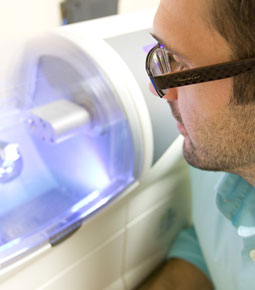
Bridges are used to take the place of missing teeth and are a great option especially when teeth next to the space are damaged. A bridge is one or more artificial teeth that are cemented into place using the teeth on either side for support, hence the name. A bridge replaces the missing tooth, both functionally and cosmetically. Bridge work is as much an art as it is an exact science. The materials used may be porcelain bonded to metal alloy or all ceramic material made to match your natural tooth color.
« Return to Services List
CROWNS

A crown, also referred to as a cap, is used to entirely cover a damaged tooth. A crown not only strengthens a tooth, but it can dramatically improve a tooth's appearance, shape and alignment. Our office is special in that it only takes one appointment for a crown compared to two appointments at other dental offices. This is done with the CAD/CAM milling system which creates porcelain and ceramic crowns that beautifully match or improve your teeth.
Crowns may be used to:
- Replace a large filling when there is little tooth structure remaining
- Protect a weak tooth from fracturing
- Restore a fractured tooth
- Attach a bridge
- Cover a dental implant
- Cover a discolored or poorly shaped tooth
- Cover a tooth that has had root canal treatment
To see more information related to crowns please see the link for CAD/CAM.
« Return to Services List
WHITENING INCLUDING ZOOM!
Tooth whitening is a popular procedure to make teeth whiter and brighter, and therefore more attractive. Bleaching can be used to whiten stained and discolored teeth, or simply to enhance a dull smile. Either way, tooth whitening is a safe and relatively painless procedure ideal for most patients. Our office utilizes the take home whitening trays.
Tray whitening is a less expensive whitening treatment often with better results compared to other offices "in-office" treatments. You can use these while in the comfort of your own home to gradually whiten teeth. We will first take an impression of your teeth to create a customized clear tray that you will wear to whiten your teeth. Within a few days your trays will be ready to be picked up and we will show you how to apply the special bleaching material to the trays. The whitening gel trays should be worn 30-60 minutes up to twice a day. At the end of this period, you will see maximum whitening results that are nothing short of dazzling. Occasional treatment can be used at your convenience to maintain your new smile.
« Return to Services List
PERIODONTAL (GUM) TREATMENT
The gums, ligaments, and bone around the teeth form the foundation for one's teeth. All structures are also referred to as the periodontium. When the periodontium is not healthy, it jeopardizes the teeth just as a bad foundation would threaten the stability of a house. Signs of unhealthy periodontium include: gums that are red and bleed easily, persistent bad breath, gums that are pulled away from the tooth, loose teeth, and changes in the position or bite of the teeth. Any of these may be a sign of a problem. With proper gum treatments, however, it may be possible to return gum tissue to a healthy state. If you're having a problem, come in and see us so we may treat it right away. The treatment usually involves a deep cleaning or root planing done under a local anesthetic, and sometimes includes local antibiotic agents. If the gum disease gets too severe it may need to be treated through surgery or extraction. If surgery is needed, we can provide LANAP which is a laser surgery for periodontal disease that doesn’t involve scalpels or sutures. Great results have been seen with this treatment in combination with good home care. Patients who have had the scalpel surgery say LANAP is more tolerable. But the key to avoiding extensive care is to come in for treatment at the first sign of a problem.
To see more information related to gingival treatment please see the links for Soft Tissue Laser and Perio Protect.
Click the Technologies below for more information on each subject.
« Return to Technologies List
X-RAYS AND DIGITAL X-RAYS
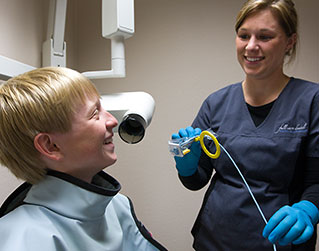
X-rays are a focused beam of x-ray particles passed through bone which produce an image on special film, showing the structure through which it passed. This provides the familiar black and white images doctors and dentists use to diagnose problems and disease. Without an x-ray of the whole tooth and supporting bone and gum tissues, there would be no way to detect infection or pathology that requires attention.
In our office we use digital radiography which allows us to take x-rays using up to 80% less radiation than conventional film x-rays. Using this technology, we are able to take an x-ray of your mouth by using a small sensor which records the image of your teeth and sends it to a computer. The result is a highly detailed image of your mouth that can easily be enhanced to better diagnose dental concerns and determine the very best treatment for each case.
« Return to Technologies List
CEREC
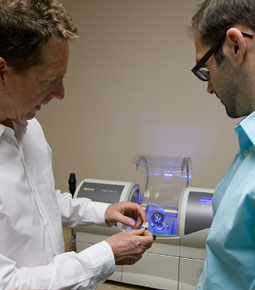
CEREC is an acronym for Chairside Economical Restoration of Esthetic Ceramics. This high-tech equipment allows us to restore damaged teeth with beautiful custom ceramic crowns in a single visit, completely eliminating the need or multiple appointments over a several week period. The process can create a ceramic dental crown, inlays, onlays or veneers using a variety of technologies including 3D photography and computer-aided design and manufacturing known as CAD/CAM.
Using an intra-oral camera, a photograph is taken of the tooth and the picture is loaded onto the computer. Using Computer Aided Design technology, the dentist is able to design the restoration and transform the image into a three-dimensional model. This valuable program then allows the dentist to easily calculate the appropriate restoration shape and size to create near perfect restoration. When the model is ready, a milling machine then creates the restoration using a high-speed diamond bur and calculated precision. The restoration is then bonded to the tooth using a resin material. The result is a beautiful and custom designed and produced restoration, made entirely to fit your mouth. CEREC crowns are metal-free and have been used for over 20 years.
« Return to Technologies List
ELECTRONIC CLAIMS
Our office utilizes electronic claims processing. This means that rather than sending your dental claim through the mail, it is sent electronically to your insurance company with the click of the button. By filing your claim electronically, information is submitted more efficiently and with fewer errors. This benefits our patients because the turn around time on claims is faster and fewer claims are returned or denied. We are happy to submit your dental claims to your insurance company on your behalf.
« Return to Technologies List
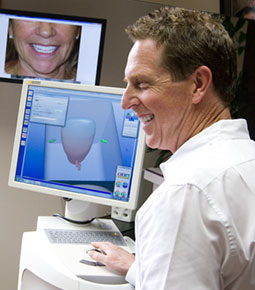
CAD/CAM CHAIRSIDE RESTORATION SYSTEM
Our office utilizes CAD/CAM technology. CAD/CAM stands for "computer-aided design" and "computer-aided manufacturing". This technology allows the dentist to use an intra-oral scanner inside your mouth to take a digital scan of a tooth that has been prepared to receive a crown. Using special software, the data from the scan is used to generate a design (CAD) for a custom crown. This program will also generate a custom blue print and guide lines to manufacture the new crown (CAM). This software, paired with a state-of-the-art milling machine, enables our office to create precise and custom crowns, inlays and onlays in one single dental visit.
To see a video on the CAD/CAM milling system please click play on the video below.
« Return to Technologies List
LASER DENTISTRY
Laser dentistry is the latest advancement in dental technology. The laser we use at our practice is an alternative to the common hand-held scalpel surgery for periodontal disease.
The soft tissue laser can also be employed to destroy bacteria in gum pockets, removing infection and allowing the tissue to return to a healthy state. The soft tissue laser enables the dentist to treat our patients with extreme accuracy and eliminates the need for stitches.
Soft tissue lasers are also used to safely remove soft tissue, such as excess gum tissue to create more aesthetic smiles or treat gingival overgrowth.